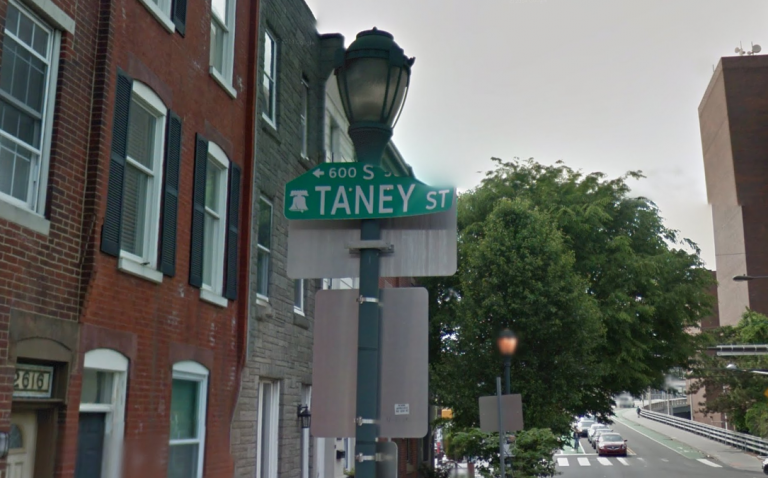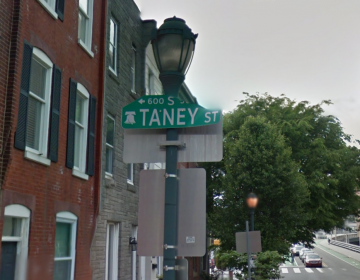A renewed push to give Taney Street a different name
Taney Street is named after Roger B. Taney, fifth chief justice of the U.S. Supreme Court and author of what is arguably its most infamous decision, Dred Scott v. Sanford.

Taney Street is named for the chief justice of the U.S. Supreme Court who wrote the infamous Dred Scott decision. (Google Maps)
This story originally appeared on PlanPhilly.
—
A petition to rename Taney Street has gotten a boost, with its backers touting the mayor’s support of the effort in a renewed push.
George Basile, a Temple University senior, launched the petition last summer, receiving a brief flurry of attention around the same time Philadelphia debated removing a statue of former Mayor Frank Rizzo from the steps of the Municipal Services Building.
Taney Street is named after Roger B. Taney, fifth chief justice of the U.S. Supreme Court and author of what is arguably its most infamous decision, Dred Scott v. Sanford.
“The Dred Scott decision was unequivocally the worst legal decision in American legal history,” said Basile. He updated the petition last week with a letter from Mayor Jim Kenney saying that he was “supportive of changing the name of Taney St.,” but noting that it’s City Council that has the power to name streets through ordinances.
According to spokeswoman Jane Roh, City Council President Darrell Clarke “would absolutely favor a name change.”
Councilman Kenyatta Johnson also released a statement in favor of the idea. “I’m open to renaming Taney Street and look forward to having a conversation about it,” Johnson wrote.
Though it’s rare for City Council to rename streets — a re-appellation can cause headaches for residents and businesses along the newly designated route — it’s not unheard of. In 1992, City Council renamed a portion of Delaware Avenue Christopher Columbus Boulevard, courting controversy along the way. The council had an easier go earlier in the decade, renaming East River Drive (now Kelly Drive) and Columbia Avenue (now Cecil B. Moore Avenue).
Taney Street runs intermittently between 26th and 27th Streets through Grays Ferry, Fitler Square, Fairmount, Brewerytown, and Strawberry Mansion, areas that Johnson and Clarke represent. If they decided to introduce an ordinance to change the street’s name, the rest of City Council would likely go along, thanks to the tradition of councilmanic prerogative.
Taney Street gained international fame in 2014, when the Taney Dragons, led by pitcher Mo’ne Davis, almost won the Little League World Series. The team is named after the baseball field, which itself is named after the street.
When asked why he decided to give last year’s petition another go, Basile said he recently did a little research into Chief Justice Taney. “His connections to Philly were almost nonexistent,” Basile said. “So, I was really confused how we even got to the point of naming a street after him.”
Philadelphia renamed Minor Street for Taney in 1858, just a year after the Dred Scott decision.
A quick, admittedly unthorough search of The Inquirer’s antebellum archives, available through the Free Library of Philadelphia, turned up no stories on the renaming of Minor Street to Taney Street in 1858, but the largely agreed-upon presumption is that the city fathers decided to honor the author of that ruling. It is possible that Philadelphia’s large Roman Catholic population decided to honor the nation’s first Catholic U.S. Supreme Court justice. Then again, they would have chosen to do so well into his tenure as chief justice and years before his death in 1864. Taney was from Maryland, and his only real connection with the area is a tenuous one — he attended Dickinson College in Carlisle, Pa., returning to Annapolis to read law after graduation.
Taney Street was extended in 1895 and again in 1897, as more streets running essentially the same route took on the name.
If not for Dred Scott v Sanford, Justice Taney might be remembered far differently today. He joined Justice Joseph Story’s 7-1 decision in United States v. The Amistad, which found that Africans that managed to overthrow their captors and would-be slavers on the high seas were considered free foreigners. Dred Scott, however, effectively overruled that case without naming it, holding that the Constitution denied citizenship to “a negro, whose ancestors were imported into [the U.S.], and sold as slaves.” The decision also ended the Missouri Compromise, precipitating the Civil War.
The 15th Amendment was written specifically to overturn Dred Scott, which is widely regarded as one of the most shameful decisions in the court’s history.
WHYY is your source for fact-based, in-depth journalism and information. As a nonprofit organization, we rely on financial support from readers like you. Please give today.






